An Interview With Susan Lowdermilk
Susan is a book artist and printmaker working in traditional processes such as woodcut, wood engraving and intaglio etching as well as in digital media. Her recent artist’s book projects involve movable parts, pop-ups and LED circuitry. Her books are included in many university library collections and public collections such as the Getty Museum, the University of Washington and the New York Public Library. Her work is represented in galleries throughout the United States. She is a professor at Lane Community College in Eugene, Oregon where she has been teaching courses in printmaking, artist books and graphic design for two decades. Susan earned her Master of Fine Arts from the University of Oregon and her Bachelor of Fine Arts from Colorado State University in Fort Collins, Colorado.
We recently had a chance to talk with Susan about her work and approach to teaching:
- What inspires you about the tunnel book?
Tunnel books intrigue me with the compelling visual illusions of depth and perspective that can be achieved with this simple and transparent design form. Tunnel books (or peep show books) were originally created as Victorian optical toys. They were usually a literal picture in three dimensions of popular scenes or commemorative events. As an artist, movable books offer me rewarding design challenges. They also offer visual rewards for the viewer as the closed book goes from a flat object, then comes to life as a three dimensional kinetic form. As our relationship to the traditional codex book changes and our experience shifts to reading more and more on digital devices, I become more interested in the retrograde analog, tactile, simple, technology of movable and pop-up books.
- Are there challenges to teaching book arts?
In teaching book arts some typical challenges that I manage with my students are: following an appropriate design process and time frame, keeping projects to a manageable scope for the time allotted, and not putting too many ideas into one project. These are challenges that I face with my own projects as well. I find that since the book is such a familiar object, students are typically eager to create them with own narratives. My class at Lane Community College is called “Artist Books and Pop-up.” Our student body is made up of all ages and backgrounds. I teach Art and Design majors as well as students from other disciplines. This makes for a rich and interesting atmosphere in the classroom where students share ideas, and often help each other problem solve conceptually as well as technically using the knowledge unique to their own life experiences.
- Anything you want to say about your philosophy and approach to teaching and or the book arts?
I believe that every design choice in an artist book project should be in service to support the book’s content. The text (or the concept if no text is present) should inform all choices like color, font choice, type treatment, size, materials etc. An artist’s book is well realized when it communicates the artist’s vision, at the same time that it functions as a kinetic, tactile object able to be explored.




